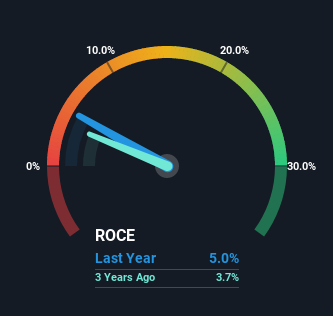- United States
- /
- Healthcare Services
- /
- NasdaqGM:RDNT
RadNet (NASDAQ:RDNT) Is Reinvesting At Lower Rates Of Return

If we want to find a stock that could multiply over the long term, what are the underlying trends we should look for? Firstly, we'll want to see a proven return on capital employed (ROCE) that is increasing, and secondly, an expanding base of capital employed. Put simply, these types of businesses are compounding machines, meaning they are continually reinvesting their earnings at ever-higher rates of return. Although, when we looked at RadNet (NASDAQ:RDNT), it didn't seem to tick all of these boxes.
Understanding Return On Capital Employed (ROCE)
Just to clarify if you're unsure, ROCE is a metric for evaluating how much pre-tax income (in percentage terms) a company earns on the capital invested in its business. Analysts use this formula to calculate it for RadNet:
Return on Capital Employed = Earnings Before Interest and Tax (EBIT) ÷ (Total Assets - Current Liabilities)
0.05 = US$87m ÷ (US$2.1b - US$381m) (Based on the trailing twelve months to March 2022).
Thus, RadNet has an ROCE of 5.0%. In absolute terms, that's a low return and it also under-performs the Healthcare industry average of 10%.
See our latest analysis for RadNet

Above you can see how the current ROCE for RadNet compares to its prior returns on capital, but there's only so much you can tell from the past. If you'd like, you can check out the forecasts from the analysts covering RadNet here for free.
How Are Returns Trending?
In terms of RadNet's historical ROCE movements, the trend isn't fantastic. Over the last five years, returns on capital have decreased to 5.0% from 6.6% five years ago. However, given capital employed and revenue have both increased it appears that the business is currently pursuing growth, at the consequence of short term returns. If these investments prove successful, this can bode very well for long term stock performance.
In Conclusion...
Even though returns on capital have fallen in the short term, we find it promising that revenue and capital employed have both increased for RadNet. And long term investors must be optimistic going forward because the stock has returned a huge 129% to shareholders in the last five years. So should these growth trends continue, we'd be optimistic on the stock going forward.
Since virtually every company faces some risks, it's worth knowing what they are, and we've spotted 5 warning signs for RadNet (of which 1 is significant!) that you should know about.
While RadNet may not currently earn the highest returns, we've compiled a list of companies that currently earn more than 25% return on equity. Check out this free list here.
If you're looking to trade RadNet, open an account with the lowest-cost platform trusted by professionals, Interactive Brokers.
With clients in over 200 countries and territories, and access to 160 markets, IBKR lets you trade stocks, options, futures, forex, bonds and funds from a single integrated account.
Enjoy no hidden fees, no account minimums, and FX conversion rates as low as 0.03%, far better than what most brokers offer.
Sponsored ContentNew: AI Stock Screener & Alerts
Our new AI Stock Screener scans the market every day to uncover opportunities.
• Dividend Powerhouses (3%+ Yield)
• Undervalued Small Caps with Insider Buying
• High growth Tech and AI Companies
Or build your own from over 50 metrics.
Have feedback on this article? Concerned about the content? Get in touch with us directly. Alternatively, email editorial-team (at) simplywallst.com.
This article by Simply Wall St is general in nature. We provide commentary based on historical data and analyst forecasts only using an unbiased methodology and our articles are not intended to be financial advice. It does not constitute a recommendation to buy or sell any stock, and does not take account of your objectives, or your financial situation. We aim to bring you long-term focused analysis driven by fundamental data. Note that our analysis may not factor in the latest price-sensitive company announcements or qualitative material. Simply Wall St has no position in any stocks mentioned.
About NasdaqGM:RDNT
RadNet
Provides outpatient diagnostic imaging services in the United States and internationally.
Good value with adequate balance sheet.
Similar Companies
Market Insights
Community Narratives



